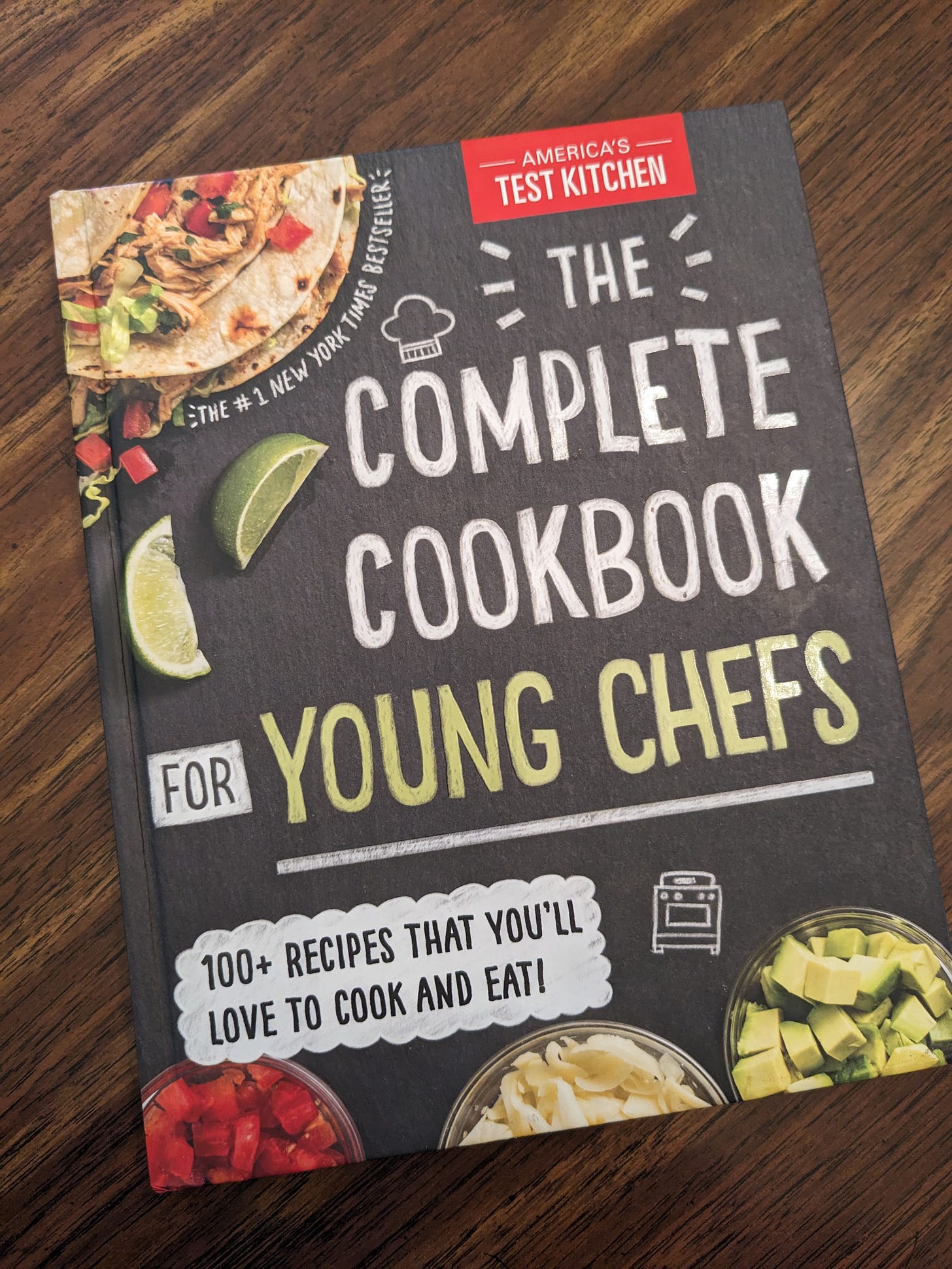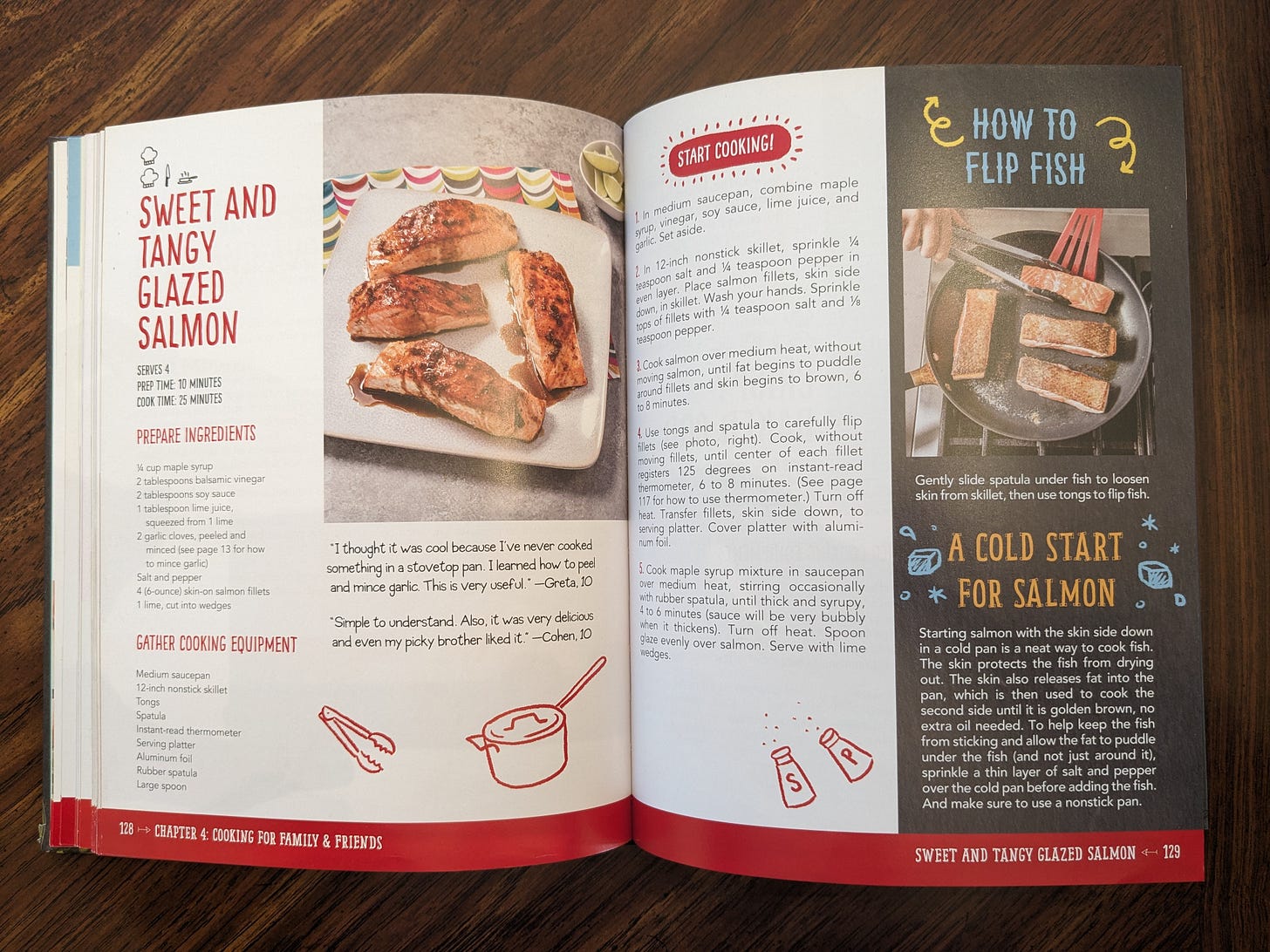Dinner is Served: The Complete Cookbook for Young Chefs
Recipes and instructions just for kids.
Happy 2024! The new year is in full swing, even though we haven’t quite put away all of our Christmas decorations, and school and activities are off to a somewhat sluggish start (thanks in part to a bout of RSV and our first real snowstorm of the season). I’ve never been one to make official resolutions, but I do always find myself renewing my commitment to good health, good organizational skills, and a greater effort to grow my intellect. Not very quantifiable, but I guess more of a vague “shoot for the moon and land among the stars” approach. If you, however, have resolved to cook less and to get your kids to cook more (I already did this a couple of years ago!), then today’s review is right up your alley.
Teaching my kids to cook, and fostering a love for working in the kitchen, have always been top priorities for me. I even hoped to regularly schedule cooking lessons into our school weeks at one point, but it was one of those “extracurriculars” that always seemed to fall by the wayside amid all of the other Things My Children Should Know By the Time They Become Adults. Luckily, my two older kids have an inherent enthusiasm for cooking. For a while this manifested as wild and random experimentation, which mostly resulted in my husband and I (and other unwitting relatives who happened to be visiting) having to choke down baking soda-laden muffins without gagging on them, and then trying to find something nice to say before banning the kids from the use of baking soda. It’s highly likely that one of these episodes is what led my sister to gift our daughter a really fantastic kids’ cookbook, America’s Test Kitchen’s The Complete Cookbook for Young Chefs.
I loved the book immediately— it’s colorful, modern, straightforward, and chock full of information that any young cook might want to know, or didn’t even know he/she wanted to know. Even better, my daughter loved it immediately, and continues to use it probably weekly, having owned it now for several years. If you’re not familiar with the show “America’s Test Kitchen”, first of all, you should be. It’s been around since 1992 and is a mainstay on PBS stations. As the name implies, the hosts of the show test both recipes and kitchen equipment, and report on their findings, giving their audience a guide to the best methods for cooking chili or chocolate mousse. When it comes to meticulous cooking versus “a little of this, a little of that,” I see advantages to both ends of the spectrum. As much as I love ATK, I also love some cooks’ more laid-back approaches, and I’ve learned a lot of Lebanese cooking from my mother-in-law, whose measurements are often “about this much.” But as I’ve told my kids when they want to dump “about this much” baking soda into their muffin mix, it’s important to learn from the experts and be precise, and then you’ll be more successful when you improvise.
The most noticeable quality of this cookbook, that sets it apart from many others in the category of kids’ cookbooks, is that it doesn’t “talk down” to the young chef. These are not recipes teaching a child how to smear hummus on a tortilla and roll it up; rather, these recipes and tips give kids an impressively thorough foundation for all types of cooking, using knives, skillets, food processors, and more. To be honest, I would have found this cookbook invaluable had it been available to me as a 20-something who was beginning to cook for herself. The recipes run the full gamut, from simple meals for one or two, such as grilled cheese or tomato soup (which my daughter often makes for her lunch when she can’t find anything else she wants), to more complicated family meals, treats, and snacks. Some recipes are classics that most kids love, while others are a bit more adventurous. Recipes are given a rating of one to three “hats” to show their level of difficulty. And each recipe has reviews from kids, some of which even offer a little criticism (“didn’t have enough spice,” or “took a long time to make”). The book also contains multiple sections that offer general tips for young cooks, like kitchen safety, the many ways to cook eggs, and “decoding kitchenspeak.”
Because of the wide spectrum of recipes offered, I’d say that The Complete Cookbook for Young Chefs would be appropriate for kids as young as 7 or 8, and would probably serve their purposes at least through early high school (a confident, ambitious cook might be ready for more “mainstream” recipes by middle school, but continue to come back to favorites in this book). But wait— there’s more! America’s Test Kitchen also published The Complete Baking Book for Young Chefs, and it’s just as good. (Pro tip: the tear-and-share pepperoni pizza rolls are addictive.)
Teaching your kids to cook is an all-around win: it’s an important skill for them to learn, it’s a way for them to contribute to family life, and it can even be a way for them to express themselves. These America’s Test Kitchen cookbooks are a great guide with a delicious finished product.





